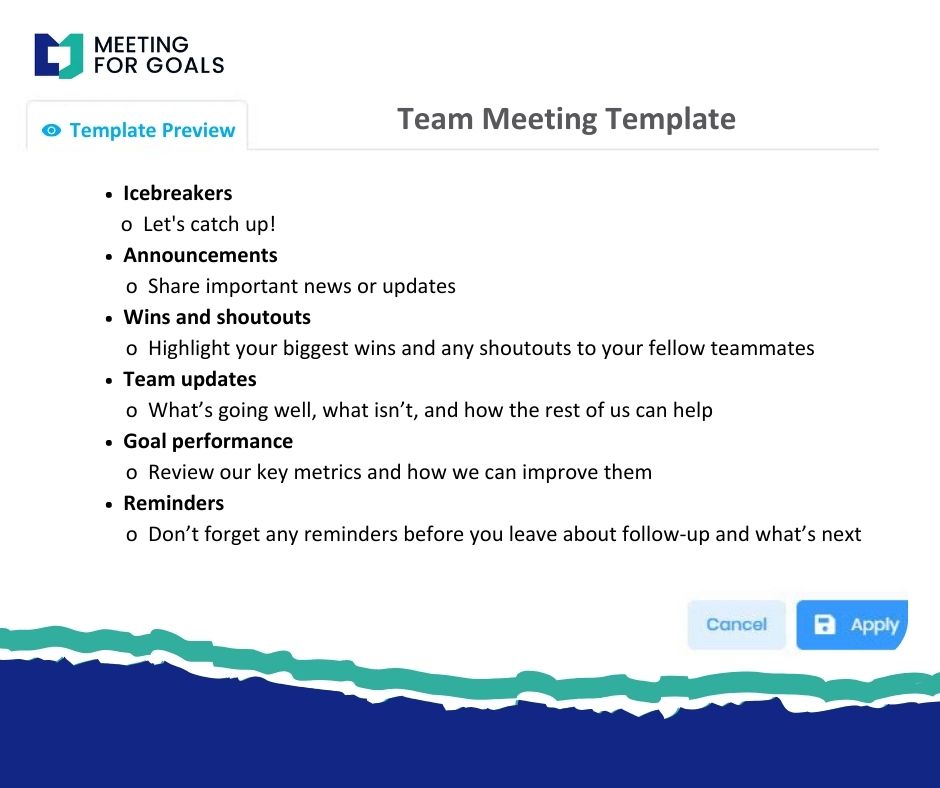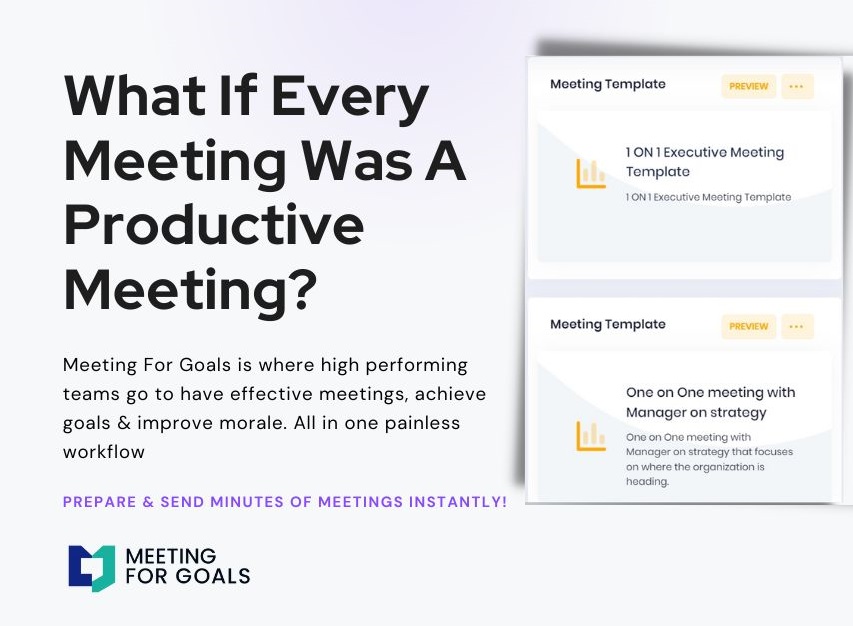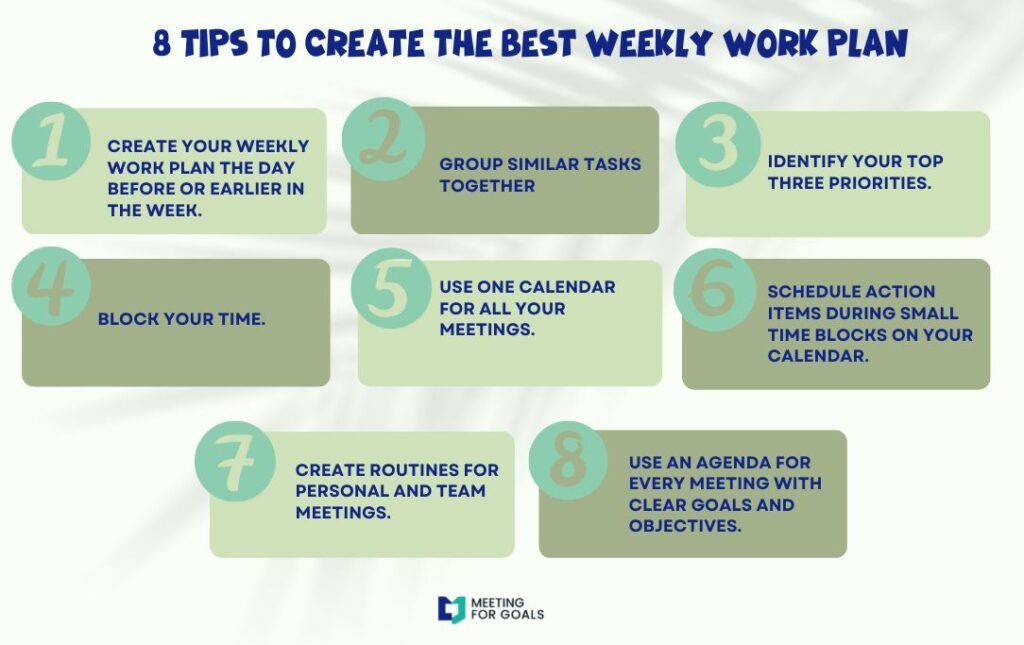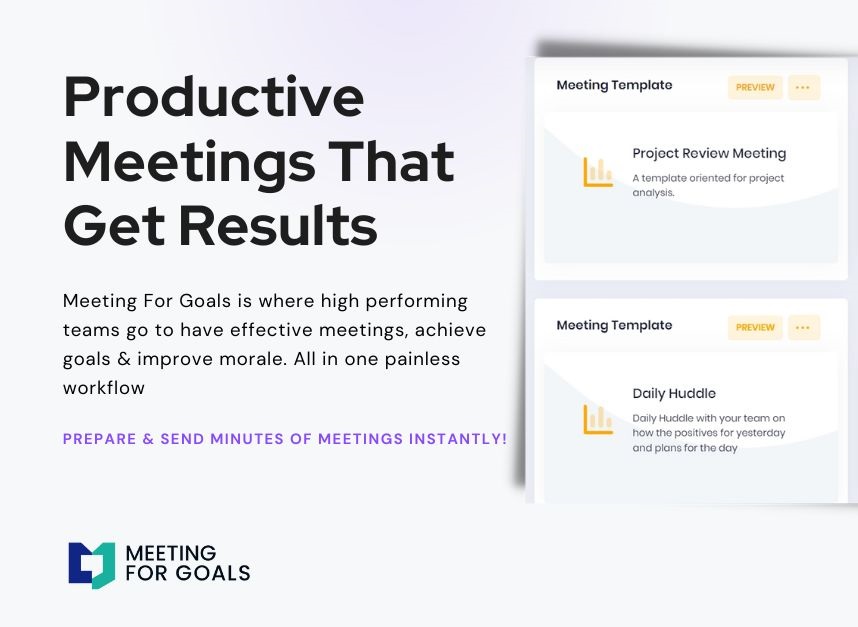In today’s fast-paced business environment, unproductive meetings are more than just an annoyance—they’re a drain on time, money, and morale. For leadership teams managing 40–70 employees, ensuring every meeting drives real results is a must. That’s where meeting norms come in.
Meeting norms are the behavioral and procedural guidelines that shape how your team collaborates during meetings. When done right, they boost accountability, improve communication, and align every meeting with your company’s bigger goals.
In this guide, we’ll explore the power of meeting norms and how Meeting For Goals—the ultimate meeting management software—can help you implement, monitor, and evolve them to maximize team productivity.
If you’re looking to build a culture of productive, goal-driven meetings, start by exploring our free meeting templates at https://meetingforgoals.com/meeting_templates or sign up today at https://app.meetingforgoals.com/TenantRegistration/Register.
Meeting Norms: The Foundation of Productive, Goal-Oriented Meetings
2 Minute Video
Watch a 2 minute demo of our meeting management software in action
I. Introduction
Meetings are essential to running a business, especially for teams in the 40–70 employee range. But without structure, they can quickly become a waste of time. That’s where meeting norms make all the difference.
Meeting norms are simply the agreed-upon rules for how meetings are run. They cover everything from showing up on time to how decisions are made. These norms create a shared understanding of what’s expected. This makes meetings more efficient and productive.
For leadership teams—Directors, VPs, C-Suite execs—meeting norms are a strategic asset. With multiple departments and high-stakes decisions in play, you can’t afford to have meetings that go off the rails.
That’s where Meeting For Goals comes in. Our software helps teams run shorter, more focused meetings by aligning agendas with business goals, assigning responsibilities, and tracking follow-ups—all in one intuitive platform.
Whether you’re overhauling your meeting structure or fine-tuning an already high-performing team, this guide will give you the tools to transform your meetings into strategic powerhouses.
II. What Are Meeting Norms—and Why Do They Matter?
Meeting norms are shared agreements that guide how your team behaves during meetings. Think of them as the unwritten rules that keep things moving smoothly.
There are three main types of meeting norms:
- Behavioral Norms – These cover how people act in meetings. Examples: active listening, no multitasking, and showing respect to all voices.
- Procedural Norms – These define how the meeting flows. Examples: having a set agenda, starting and ending on time, and assigning clear roles.
- Cultural Norms – These reflect your company’s values. For instance, a company that values transparency might encourage open feedback and honest discussion.
When norms are clearly defined and consistently followed, the benefits are huge:
- Meetings become more efficient
- Communication improves
- Accountability increases
- Team morale gets a boost
According to a study by Harvard Business Review, teams that set clear meeting norms are significantly more productive and engaged. You can read more about the research here: https://hbr.org/2017/07/stop-the-meeting-madness.
For leadership teams, these norms aren’t just nice to have—they’re essential. They help teams stay aligned, make faster decisions, and follow through on actions. When you use a platform like Meeting For Goals to embed these norms into your workflows, it becomes second nature.
III. Key Components of Effective Meeting Norms
Let’s break down the core elements every team should include in their meeting norms.
A. Punctuality and Attendance
Time is valuable—especially for executives. Meetings should start and end on time. Decide who really needs to be there and who can be updated later. This keeps meetings lean and focused.
Establishing a norm that meetings won’t wait for latecomers sets a tone of respect for everyone’s schedule.
B. Accountability in Roles and Responsibilities
Every meeting should have clear roles:
- Facilitator: Guides the meeting
- Timekeeper: Keeps things on schedule
- Note-taker: Captures key points and action items
- Task owners: Responsible for follow-ups
When everyone knows their role, meetings run smoother. With Meeting For Goals, assigning and tracking these roles is built right into the platform—so nothing falls through the cracks.
C. Communication and Engagement Guidelines
Set expectations for how people engage in meetings. Some examples:
- Speak one at a time
- Listen actively
- Use data to back up points
- Keep side conversations to a minimum
For virtual meetings, norms like “cameras on” can help boost engagement and accountability.
Encouraging participation from everyone—not just the loudest voices—leads to better decisions and a more inclusive culture.
D. Decision-Making and Conflict Resolution
Define how decisions are made. Will it be by consensus, majority vote, or executive call? Everyone should know the process upfront to avoid confusion.
Also, have a plan for resolving disagreements. Encourage respectful debate, but make sure there’s a clear path to resolution. This keeps meetings productive, even when opinions clash.
Meeting For Goals helps you document and reinforce these norms so they’re not forgotten after the meeting ends.
IV. How to Implement Meeting Norms with Meeting For Goals
Creating norms is one thing—putting them into practice is where the magic happens. That’s where Meeting For Goals becomes your secret weapon.
A. Set and Track Norms with Built-In Tools
With Meeting For Goals, you can embed norms directly into your meeting templates. Whether it’s a weekly leadership sync or a project kickoff, you can set expectations for behavior, participation, and follow-through right in the agenda.
Assign roles like facilitator or note-taker with just a few clicks. The app sends reminders, so everyone comes prepared and knows what’s expected.
B. Customize Norms for Different Teams and Goals
Not every team works the same way. Your marketing team may need brainstorming sessions, while your finance team needs structured reviews.
Meeting For Goals lets you create custom templates and norms for different meeting types. You can even adjust them over time as your team grows or your needs change.
This flexibility ensures your norms stay relevant—not rigid.
C. Real-World Examples of Norms in Action
Here’s how teams are using Meeting For Goals to turn norms into action:
- Pre-set agendas with time blocks for each topic
- Automated follow-up emails with action items and deadlines
- Real-time decision tracking during meetings
- Integration with tools like Asana or Trello for seamless follow-through
These features make it easy to stick to your meeting norms—and get results.
To see how it works, check out our free meeting templates at https://meetingforgoals.com/meeting_templates.
V. Monitoring and Evolving Your Meeting Norms
Meeting norms aren’t set in stone. Your team will grow, your goals will shift, and your norms should evolve too.
A. Create Feedback Loops
Ask your team what’s working—and what’s not. Use anonymous surveys or open discussions to gather feedback.
Are meetings too long? Are people confused about their roles? Are some norms being ignored?
Meeting For Goals makes it easy to collect and analyze this feedback, so you can make smart, data-driven changes.
B. Adapt Norms as Your Team Develops
Startups may need daily check-ins. Larger teams might benefit from weekly strategy sessions. As your team matures, your meeting norms should evolve.
For example, as projects become more complex, you might introduce stricter documentation norms or more detailed agendas.
With Meeting For Goals, you can easily update your templates and workflows to match your team’s current needs.
C. Use Analytics to Measure What Matters
One of the most powerful features of Meeting For Goals is its analytics dashboard. You can track:
- Meeting duration
- Attendance rates
- Task completion
- Agenda adherence
These metrics help you see whether your norms are working. If completion rates are low, maybe you need stronger accountability norms. If meetings run over time, it could be a sign to tighten your agenda structure.
By measuring what matters, you can fine-tune your meeting practices for better outcomes.
VI. Real-World Success Stories
Many companies have already transformed their meetings using Meeting For Goals. Here are a few examples:
A mid-sized tech firm used our templates to standardize their leadership meetings. Within two months, they reduced meeting time by 30% and doubled their action item completion rate.
A nonprofit organization used Meeting For Goals to improve cross-department collaboration. By setting clear norms and tracking follow-ups, they saw a 40% boost in project delivery speed.
These stories show that with the right tools and mindset, better meetings aren’t just possible—they’re inevitable.
VII. Conclusion
Meeting norms are more than just rules—they’re the foundation of effective collaboration. For companies with 40–70 employees, strong meeting norms can be the difference between chaos and clarity, between wasted time and focused execution.
From punctuality and participation to decision-making and accountability, the right norms turn meetings into strategic tools for progress.
With Meeting For Goals, you don’t have to do it alone. Our platform helps you define, implement, and evolve meeting norms that align with your business goals.
With features like customizable templates, real-time collaboration, and performance analytics, we give you everything you need to make meetings work for you.
If you’re ready to run shorter, sharper, and more impactful meetings, it’s time to get started.
Sign up today at https://app.meetingforgoals.com/TenantRegistration/Register or explore our free meeting templates at https://meetingforgoals.com/meeting_templates.
For more tips and tools on running effective meetings, visit us anytime at https://meetingforgoals.com.
Let’s turn every meeting into a step toward achieving your company’s goals.




